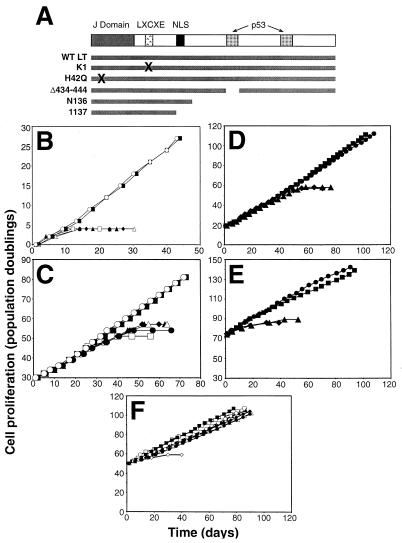FIG. 3.
Effects of LT mutant forms on replicative senescence and crisis. (A) Schematic representation of LT mutant forms. LXCXE, binding site for pRB family members; NLS, nuclear localization signal; X, amino acid substitutions that disrupt LT function; WT, wild type. Δ434-444 has a small in-frame deletion that eliminates p53 binding. (B) Effects of LT mutant forms on replicative senescence in HEK cells. HEK cells were infected with a control retrovirus (open squares) or with a retrovirus encoding an LT mutant form. Wild-type LT (filled squares), K1 (filled triangles), H42Q (open circles), Δ434-444 (open triangles), N136 (filled diamonds), and 1137 (filled circles) are shown. (C) Effects of LT mutant forms on replicative senescence in BJ cells. Symbols are the same as in panel B. (D) Effects of LT mutant forms on crisis in HEK cells. HEK cells expressing LT with (squares) or without (diamonds) hTERT or the LT H42Q mutant form with (circles) or without (triangles) hTERT are shown. (E) Effects of LT mutant forms on crisis in BJ cells. hTERT was introduced after the indicated cells had bypassed replicative senescence. Symbols are the same as in panel D. (F) Effects of LT mutant forms on immortalization in BJ fibroblasts expressing hTERT prior to introduction of the mutant forms. Symbols are the same as in panel B. Open diamonds represent the proliferation of BJ fibroblasts infected with only a control retrovirus.

